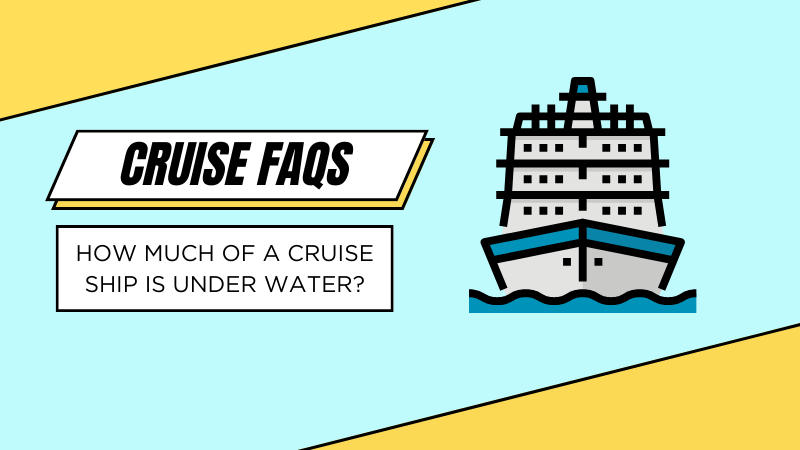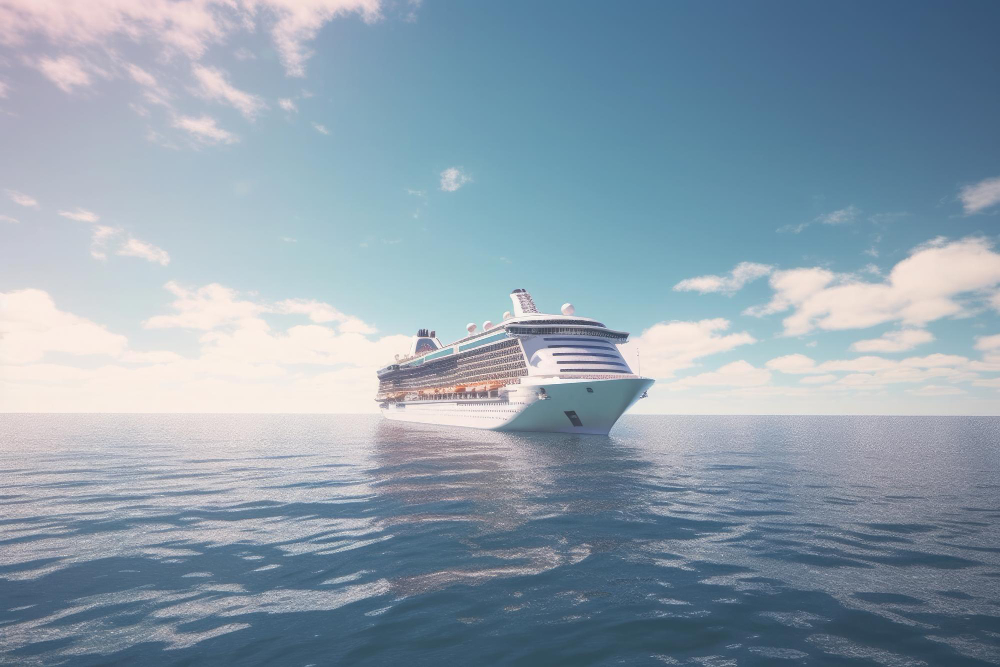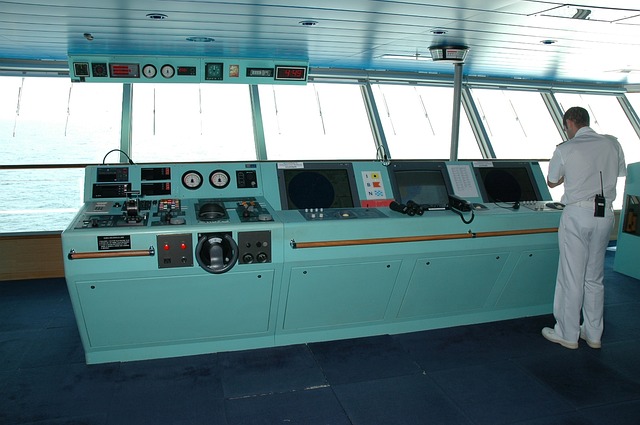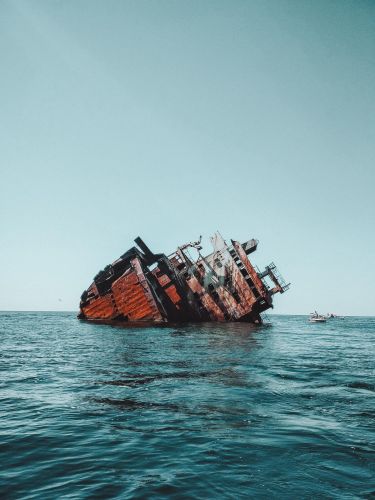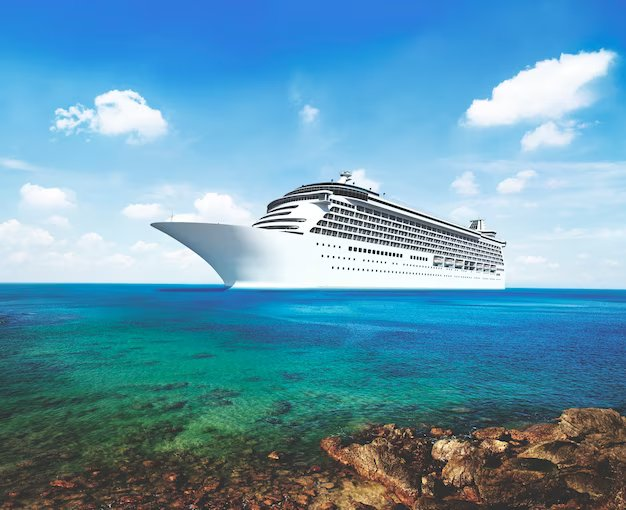Have you ever thought about how cruise ships are like big floating cities? They’re huge and have all sorts of fancy stuff on board. It’s pretty cool, right? Yet, behind the glamour is an engineering marvel that most people overlook. One question that frequently arises is: how much of a cruise ship is under water? Understanding this not only satisfies curiosity but also sheds light on the intricate design and safety measures in place, including how fast cruise ships go.
In this blog post, we will delve into the nautical intricacies of how cruise ships float, including the typical cruise ship draft, why a cruise ship floats, and what actually goes on beneath the water line. Climb aboard as we delve into the hidden facets of these buoyant marvels.
How Is It That a Cruise Ship Remains Buoyant?
Cruise ships are fascinating because they can remain afloat despite their enormous weight and size. Archimedes’ principle is the key to their buoyancy. In essence, this rule posits that an object immersed in a fluid encounters an upward force equal to the weight of the fluid it has displaced.
Imagine a cruise ship that has a hull shaped like a “U.” This unique design causes the water to move outward and downward when the ship is in the water. As the water tries to flow back into the space, it creates energy that pushes the ship upward, helping it stay afloat. Marine engineers refer to this as ‘the first condition of equilibrium.’
So, whether it’s the grand Carnival Glory or a smaller ship, the upward buoyant force exerted on any cruise ship is precisely balanced against the weight of the ship coming into water displaced. This balancing act allows cruise ships to sail safely, even in rough seas.
This understanding of buoyancy is crucial as it directly impacts the cruise ship’s overall height, stability, and safety.
How Much of a Cruise Ship Is Under Water?
When you see a massive cruise ship gliding smoothly through the sea, it’s easy to forget that a significant portion of it is actually submerged. So how much of a cruise ship is underwater? To answer this, we look at a measurement called the draught.
The draught is the distance from the ship’s keel (the lowest point of the ship sits or hull) to the water’s surface. This varies among cruise ships, but for context, smaller ships might have a draught of around 20-30 feet. Some of the globe’s most colossal cruise liners, such as Royal Caribbean’s Symphony of the Seas, can boast a draught going beyond 31 feet.
Multiple elements play a role in determining a cruise ship’s draught:
- Shape of the Hull: The design and shape of the cruise ship’s hull play an essential role in determining the draught.
- Weight of the Ship: This includes everything from the decks underwater the engines, fuel tanks, and superstructure to amenities and cabins.
- Passenger and Luggage Weight: The combined mass of the travelers and their baggage can also have an impact on the ship’s draught.
Archimedes’ principle helped us understand that the force that keeps a ship afloat is equal to the weight of the water it displaces. For instance, Royal Caribbean’s Oasis-Class cruise ships typically displace roughly 100,000 tons of water. This means that the buoyant force needs to be at least 100,000 tons to keep the ship afloat. Let’s talk numbers for clarity:
- A typical cruise ship draft is usually around 8.8 meters (approximately 28 feet).
- Royal Caribbean’s Oasis-class ships, some of the largest in the world, have a draft of about 30 feet 7 inches.
Draught measurements are vital as they dictate the ports that a cruise ship can access. Smaller ships with shallower drafts can dock at smaller, less-touristy ports, offering a different cruising experience.
Environmental and Safety Implications
Understanding how much of a cruise ship is underwater is not just a fun fact but also has real-world implications. From an environmental standpoint, knowing the draught helps minimize damage to marine ecosystems, as ships can better avoid shallow reefs or sensitive seabed areas. Furthermore, it assists in the controlled release of ballast water, which may harbor invasive organisms.
On the safety front, understanding the draught is essential for stability, especially in rough seas. Cruise lines take this into account when determining emergency protocols and safety measures like ballast tanks and weight distribution, ensuring that your time at sea is as secure as it is enjoyable.
How Many Floors Are Below Water on a Cruise Ship?
It is common to wonder about the number of floors that are situated below the waterline on a cruise ship. This varies from one ship to another, but generally, one or two decks are submerged, housing everything from the engine room to rooms and food storage to crew cabins.
For example, on many cruise ships, the first few decks are usually below water, containing essential operating components and staff accommodation. Knowing this can add a new layer of fascination as you wander through the ship, enjoying amenities that are above sea level while being aware of a whole operational world beneath you.
What Facilities Are Typically Found on a Cruise Ship Beneath the Waterline?
Cruise ships typically house essential facilities below the waterline, such as the engine room, water treatment plants, air conditioning units, fuel bunkers, water storage tanks, plumbing units, and crew cabins. Passengers do not have underwater cabins, as these areas are reserved for staff, ensuring ship safety and functionality. Deck 2, the first fully above-water deck, often serves as the embarkation point and includes food galleys, storage, and crew dining areas.
What Are the Reasons Cruise Ships Don’t Include Underwater Viewing Areas?
Cruise ships do not typically include underwater viewing areas for practical reasons. These areas would often offer a view of turbulent water, providing little to see. Additionally, the glass used for such windows would be more vulnerable to damage than the ship’s steel hull, raising safety concerns, and maintenance costs. Designing and adding these areas also require complex structural changes and pose engineering challenges. Passenger comfort and demand are limited, and the cost of building and maintaining underwater viewing areas is high. As a result, cruise ships prioritize other amenities and services, leaving specialized vessels like submarines for those seeking underwater experiences.
Is It Possible for a Cruise Ship to Experience a Rollover?
The thought of a cruise ship sinking or experiencing a rollover is the stuff of nightmares, and thankfully, it’s an extremely rare occurrence. Modern cruise ships are designed with a low center of gravity and wide hull to maximize stability. They also have ballast tanks that can be adjusted for better weight distribution, helping the ship to stay afloat even in rough waters.
Furthermore, marine engineers take into account various other safety measures, such as the division of the ship into two adjacent compartments, that can be sealed off in emergencies. So, while the physics behind it is complex, the outcome is designed for passenger safety.
What Prevents a Ship From Tipping?
When you gaze upon a towering cruise ship, you might wonder how something so massive avoids tipping over. The secret lies in the marvel of engineering that combines a wide hull, often referred to as “the water plane area,” and a low center of gravity. These two factors work in tandem to provide stability. But that’s not all. Cruise ships are equipped with ballast systems that can adjust the ship’s weight distribution by filling or emptying tanks with water.
There are also mechanical stabilizers, which extend like fins from the sides of the ship, reducing the roll when at sea. Another vital component is the bilge keels, long metal fins along each side of the ship, which help limit rolling. Rest assured, a multitude of safety measures are in place to keep the ship stable and upright.
What Are the Consequences of a Cruise Ship Tipping Over?
The idea of a cruise ship tipping over is terrifying but highly improbable, thanks to the rigorous safety measures in place. Nonetheless, should such an incident happen, the aftermath would be disastrous, spanning from the loss of life and property to environmental damage. The stability of the cruise line of ships is consistently overseen by seasoned navigational officers, who make certain that weight distribution is modified as needed to uphold safety. Though the scenario is unlikely, it underscores the importance of adhering to safety instructions during your voyage.
The Role of Ballast Systems in Keeping Ships Stable
Now, you might be asking, what exactly are ballast systems? Ballast systems are specialized tanks filled with water to help regulate the ship’s stability and buoyancy. The amount of water can be adjusted to change the vessel’s center of gravity. In dire situations, the vessel’s swimming pools might even be emptied to bring down the center of gravity, thereby enhancing stability. The ballast system plays a critical role in determining how much of the ship is underwater, effectively keeping the vessel stable even in rough waters.
By managing weight effectively and employing these advanced systems, cruise ships can withstand even the toughest marine conditions. In doing so, they provide passengers and crew members with a safe and enjoyable experience while traversing the open seas.
Conclusion
Understanding the intricate details of why and how much of a cruise ship is underwater is nothing short of fascinating. From Archimedes’ principle governing buoyancy to the role of ballast systems in maintaining stability, cruise ships are marvels of marine engineering. These sophisticated techniques ensure the vessel’s safety, whether you’re a casual traveler sipping a cocktail by the pool or a marine engineering buff interested in the ship’s mechanics. Additionally, knowing how much cruise ships cost to build and maintain is another aspect that adds to the intrigue of these floating giants.
So why does this knowledge matter? For the everyday traveler, it offers peace of mind, knowing the extraordinary measures taken to ensure your safety at sea. For engineering enthusiasts, it provides a real-world application of scientific principles, a testament to human ingenuity. Either way, this information adds a layer of depth (pun intended!) to your cruise experience.
We encourage you to delve deeper into this subject. Perhaps the next time you’re on a cruise, you’ll appreciate not just the horizon’s beauty but also the engineering marvel you’re aboard. Happy cruising!
FAQs
What part of a cruise ship is underwater?
The part of the cruise ship that’s underwater is primarily the hull, which includes the keel—the lowest point of the ship including fuel tanks, air conditioning units, laundry room, etc. This underwater section is engineered for buoyancy and stability, governed by principles like Archimedes’ law. It’s essential for keeping the vessel afloat.
How far is it from the deck of a cruise ship to the water?
The distance from the flat bottom of the deck to the water varies depending on the ship’s design and load. However, for large cruise ships like Royal Caribbean’s Oasis-class, the distance can be quite significant about 7-9 meters, often exceeding 30 feet. It can vary based on factors like weight distribution and ballast.
Is deck 3 underwater?
In most large cruise ships, Deck 3 is typically above the waterline on most ships. Nonetheless, this can fluctuate based on the design of the ship and its cargo load. It’s often where lower-level cabins and some amenities might be located but are generally not underwater.
Is deck 1 underwater?
Deck 1 is usually at or near the waterline, but not typically underwater. It’s often reserved for mechanical and operational purposes. In some smaller or differently designed ships, Deck 1 could be closer to or at the waterline and isn’t accessible to the passengers but it’s generally engineered to stay above water.

